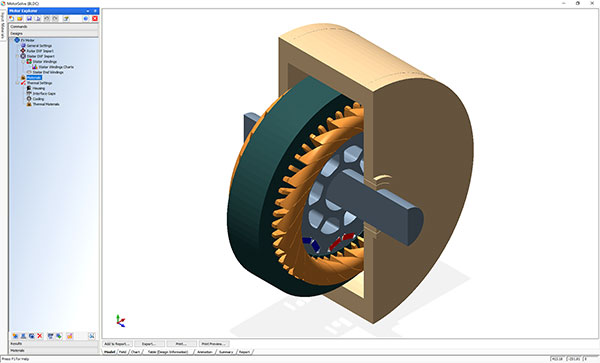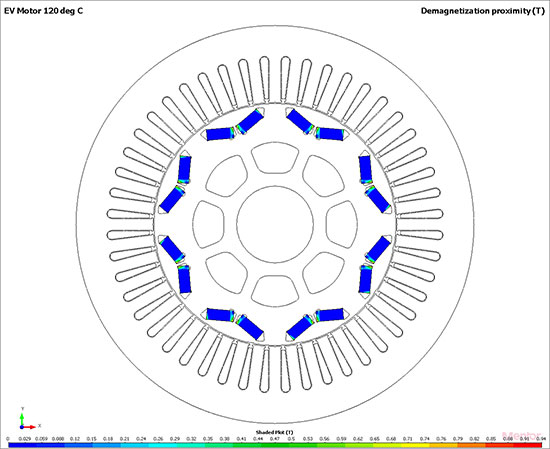
Mentor recently released version 6.3 of its Simcenter Motorsolve suite of electric machine design and analysis software for designers of electric motors and generators. Image courtesy of Mentor.
Latest News
January 30, 2019
Mentor, a Siemens business, has announced version 6.3 of its Simcenter Motorsolve portfolio of electric machine design and analysis software. Version 6.3, the company says, provides more realistic predictions of electric machine performance and extends its connectivity capabilities for systems-level analyses. Key enhancements in v6.3 include new performance efficiency maps, the ability to export files to the Simcenter Amesim platform for systems-level simulation and improved demagnetization prediction, including irreversible demagnetization. Additionally, the materials library has been updated.
Simcenter Motorsolve enables designers of electric motors and generators to prototype and simulate machine performance using equivalent circuit calculations and a dedicated finite element analysis (FEA) engine that automates such FEA operations as mesh refinements and post-processing for the end user. Simcenter Motorsolve deploys a template-based interface that is described as easy to use and flexible enough to handle most electric motor topologies. It also works with custom rotors and stators through its ability to import DXF-formatted files.

The Simcenter Motorsolve software suite offers five modules for different design and analysis needs. Among these are Simcenter Motorsolve BLDC for brushless DC and permanent magnet AC motor applications as well as Simcenter Motorsolve IM (induction machine) design software. Also in the suite are Simcenter Motorsolve SRM (switched reluctance motor) and Simcenter Motorsolve DCM, which provides brushed DC, PMDC (permanent magnet DC), wound field and universal motor design templates. The fifth module, Simcenter Motorsolve Thermal, provides thermal analysis functionalities for the Simcenter Motorsolve BLDC and Simcenter Motorsolve IM solutions.
For applications involving compact, energy-efficient variable speed drives and battery-powered devices, Simcenter Motorsolve enables users to virtually prototype an electric motor running through all possible torque-speed operating points. To that end, version 6.3 introduces new and improved performance efficiency maps that are exportable to the Simcenter Amesim platform for optimizing mechatronic system performance. These efficiency maps are magnet torque, current, advance angle, output power, loss, voltage and motor torque constant.
Version 6.3's new export to Simcenter Amesim capability allows users to transfer accurate representations of an electric motor that closely predicts actual performance. These Simcenter Motorsolve models can be used by Simcenter Amesim in a system-level simulation and performance analysis of a mechatronics device. This, Mentor explains, enables a system-level approach for performance, safety, noise vibration, harshness and emissions standards.
Four types of Simcenter Motorsolve models to Simcenter Amesim exports are supported:
- a simplified parametric characterization that can be used in the pre-sizing validation stage;
- a linear model using constant machine parameters for modeling synchronous machines;
- a non-linear model that represents the machine's behavior using DQ curves; and
- a non-linear model that takes into account non-linearities due to magnetic saturation and such spatial effects as slotting.

Demagnetization reduces an electric motor's torque and efficiency capabilities. For predicting demagnetization and its impact on performance, Simcenter Motorsolve v6.3 offers users functionality to help predict the effects of temperature demagnetization on electric motor performance as well as the demagnetizing fields due to improper load/armature current control.
The Simcenter Motorsolve materials library is intended to help increase user productivity. Version 6.3 sees updated rotor templates and other enhancements with that in mind.
Watch the Simcenter Motorsolve v6.3 highlights and new features video.
Download the Simcenter Motorsolve data sheet.
Download the white paper “Effects of Demagnetization in EV Electric Motor Simulations.”
Try Simcenter Motorsolve on the cloud for free.
See why DE's Editors selected Simcenter Motorsolve v6.3 as their Pick of the Week.
Sources: Press materials received from the company and additional information gleaned from the company's website.
More Mentor Graphics Coverage
Subscribe to our FREE magazine, FREE email newsletters or both!
Latest News
About the Author
Anthony J. Lockwood is Digital Engineering’s founding editor. He is now retired. Contact him via [email protected].
Follow DE





